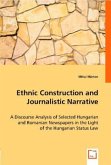The journalistic coverage of the 1992-1995 war in Bosnia-Herzegovina employed a discursive strategy that equated the events and the main protagonists of a complex civil war with a re-enactment of the Nazi Holocaust. Aiming to discover just how widespread was the use of the Holocaust analogy in the journalistic coverage of the conflict and what was its nature, this monograph analysed The Guardian and the Daily Mail in two important weeks of this conflict: August 7th-14th 1992 - the week the Serb prisioner camps were exposed - and July 13th-20th 1995 - the week of the infamous Srebrenica massacre.In the end, we argue that while its overwhelming presence made the Holocaust analogy the dominant discursive strategy on the war, its direct adoption by some of the journalists writing the stories made it the unequivocal way to interpret the Bosnian conflict.
Bitte wählen Sie Ihr Anliegen aus.
Rechnungen
Retourenschein anfordern
Bestellstatus
Storno








